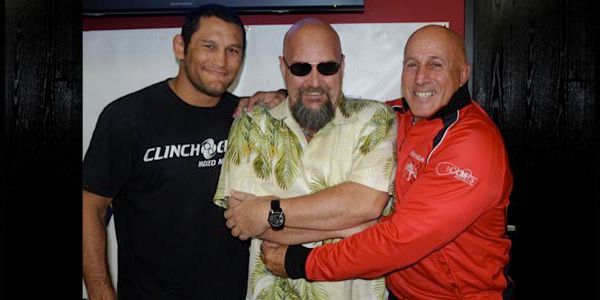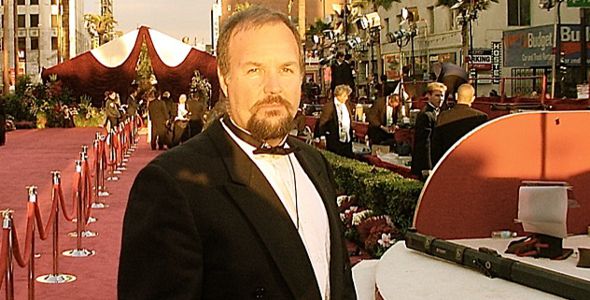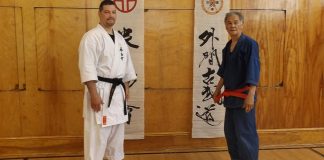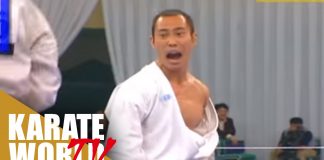Mike Murray is a well-known figure in the Mixed Martial Arts world. He was one of three people who were present, for instance, when King of the Cage was conceived. Known as “The Strangler” when he grappled on the mat, Mike also used his skills in the arena of reality as a Bodyguard to the Stars, having protected celebrities and political figures for decades. This interview helps to establish the character, goals and integrity of the mixed martial artist in the USAdojo.com.
(FD) I’m very fortunate today to be in Southern California from Seattle and have a chance to share a meal with the infamous Strangler, Mike Murray. For all of you who might be interviewing Michael in the future, it’s always a good idea to feed him first.
(Mike Murray) I appreciate that Frank and I’d like to agree that it is always a good idea to feed me first, second or last. As long as you feed me, I’ll be real happy.
(FD) He’s like a Kodiak bear. You don’t want to get into the ring with Michael if he’s hungry. In fact, you have some inside information on that. You have a friend, Dominick who actually wrestled a Grizzly. Is that correct?
(Mike Murray)
That’s funny, but don’t mix me up with this crazy behavior. A guy that I live with, Dominick Menaldi, he actually, and don’t ask me why, but he was actually the last guy to wrestle a bear. Someone thought it was a good idea and would be pretty entertaining, so he did it.
(FD) So the next question is: Who stands a better chance, the bear or an MMA fighter?
(Mike Murray)
I’m pretty sure that the bear would go about 100 and 0, and I’ve got some very good friends who are some pretty tough guys, Randy Couture, Danny Henderson. I mean, these are names that your audience probably knows. You can put them all together up against even a sissy bear, and I’m pretty certain that the bear is going to come out on top.

(FD) The ultimate toughness is probably represented by a bear, which is why there is that saying, “Sometimes you get the bear and sometimes the bear gets you.” Well, let’s get back to MMA. You’re a man who has got your thumb on the pulse of this industry. Where do you see this industry going? Not only where do you see it in the future, you can tell us where it came from. You were talking about Bloodsport earlier and how things came out of the back rooms. What are your personal thoughts about past, present and future?
(Mike Murray)
A lot of people don’t realize, now that the Ultimate Fighting Championships, the cage Fighting, the different names that they have for what has been popularized today and it is very popular, many people don’t realize that there was a Frank Dux and that you did what you did. There has always been tough guys. You were not the first and the Randy Coutures and Danny Hendersons are not going to be the last, but the sport has changed. When you did what you did, there were a lot less rules. In the beginning, when it started out there just were not that many rules. You couldn’t eye gouge and you couldn’t bite, so the sport had to be cleaned up. I’m saying “sport” because one of the things that people don’t realize is that it was, in fact a sport. Now, it is VERY MUCH a sport and the talent is off the hook! I’ve read some things about you and you talk about particular skills. If you are going to compete today in the MMA you have to be good at everything.
(FD) There is some speculation that, in the beginning, they were targeting strikers or those who were marginally trained in striking so that the sport would favor grapplers. What are your thoughts on that?
(Mike Murray)
Let’s give the Gracie family absolutely ALL the respect that they deserve. When they were going out and competing they really believed that the Gracie style was the ONLY way to go and they proved it, in the beginning. I had a friend of mine, Kimo, those of you who followed the sport, Kimo was the one who came in with the cross, he was the first one to really stay in there with Gracie. After that fight, Gracie was injured. Even Kimo had led them to believe that his art was more of a striking art. The jujitsu guys were just not used to each other. If you took the striker off his feet, not today, but then, he was in trouble.
(FD) In my era, there was this attitude of ko-ryu. You had to be pure. You could only learn karate, which is striking or jujitsu which was grappling. It wasn’t until people like John Keehan in the 1960s where you saw the combinations of the Chinese and the Japanese systems coming together. Probably one of the greatest influences in my life was Bruce Lee, not only because he brought martial arts to the forefront of our Western culture, but because he was such a fantastic philosopher. He really understood human nature, human beings and the pursuit of truth. He always talked about that. I think there is no better proving ground than the ring for truth, or in the case of your profession, you’ve worked as a bodyguard. Can you talk to us a little bit about that and maybe about what Lee was doing may have influenced you in that field?
(Mike Murray)
It’s funny you should mention that. On my Facebook page I have one of his quotations, where he talks about “being like water” to make adjustments and working within a flow. Bruce Lee was one of the first people who said that the martial artist of the future would be more of a mixed martial artists. This got him in a lot of trouble. If you remember, in the movie ENTER THE DRAGON, in the opening scene when he wins the fight he actually submits the guy into an arm-bar. The readers can go back and rent the movie and check me out on this, of course after they see the movie BLOODSPORT, but I thought that maybe Bruce Lee was responsible for the term Mixed Martial Arts. You have some other insights into this?
(FD) The first mixed martial arts matches took place in the 1930s in Chicago. Just a little later, the U.S. Marine Corp was seeking out those who they wanted to have in their program. They put a boxer against a jujitsu man in Chicago who came out of Bobby Calhoun’s gym where John Keehan was a student at the time; John Keehan, later known as Count Dante, was one of the founders of martial arts in this country. He was the right hand guy to Robert Trias who founded the very first school of martial arts in the United States. This was in Phoenix, Arizona in 1947 by Robert Trias with John Keehan who started it in the Midwest. There is a very famous photograph that Ed Parker Jr. shared with me which shows Jhoon Rhee, Bruce Lee, Ed Parker Sr., John Keehan and other martial arts legends who are all gathered together at this event, getting ready for the first full-contact fights, which were the first MMA matches.
(Mike Murray)
Getting back to the MMA, you asked me earlier about some of the changes. In the beginning it had a whole different feel to it, and I think the public saw it then, for what it was as opposed to now. In the beginning it was rough and it was brutal. Having no rules did make a difference and people were just not willing to accept it. As time went on, as with any sport, these guys got better. They seemed to change it up and realize that they really had to put rules to it. You cannot put guys like this in these octagons and NOT have tied up with some pretty good rules. We mentioned the distance between the karate guys or the strikers and the jujitsu guys or the wrestlers or grapplers. If you were in it today Frank, with your great striking ability, you would do FANTASTIC. It was come full circle, back around to striking because of the entertainment value. Today we find world champion jujitsu guys who never hit the mat!
(FD) I had an advantage in my day over fighters today, because it took much more work to get information then and many did not have that advantage. There were fighters in my time who were strikers but had never defended against a hook punch, for instance because it was not in the traditional arsenal. There were those who said that you shouldn’t weight-train because building muscles would slow you down. I defied conventions, but you are a person who has done the same. You’ve done it in body-guarding and in the ring. Where did you come from? Where did you learn your skills?
(Mike Murray)
As a young kid I felt as a lot of us probably do. I remember, and I remember the guy’s name, David Jones in third grade. For some reason we ended up under the Old Oak Tree, which was an actual old oak tree and we had our fight. In that day you didn’t tap out but you said, “I give, or yelled uncle. I wanted to do better. I liked the wrestling and that kid and I ended up becoming friends, as often happened when I was growing up. We both went into high school wrestling and from there, in college I went into judo. It was due to Title 9 because of the way they were doing funding for the schools. The less popular sports kind of fell to the side, wrestling was one of those. That’s how I went into judo, a sister sport to jujitsu. I did very well in judo and I didn’t really know anything about it.
(FD) Even the judo of our day and of today is different. Some techniques that are common today, might have been illegal in those days.
(Mike Murray)
Yes, and much of what we learned we learned from the media. I knew of you because of the movie BLOODSPORT. If it wasn’t for that movie I would never have known who you were and you were the best. If I go out to dinner with Randy Couture or Danny Henderson, or any of these guys who are on television, that’s who the audience identifies with because of television. They identify with today’s fighter as opposed to yesterday’s because of the media exposure, the Internet, the magazines. If you go to any bookstore there are dozens of mixed martial arts magazines. There’s USAdojo.com, for instance, that has great coverage of mixed martial arts. Before, when we were doing this there was only Blackbelt and Inside Kung Fu. There wasn’t that much and of course the money wasn’t there. Now the money is there. When I worked for a health club chain, I was asked by a man named Bob Anderson, now there is another remarkable coach– if I would sponsor Randy and Danny. I had trouble doing it because of the Ultimate Fighting perception being so negative. They just saw these guys as thugs. Randy’s an Academic All American. He’s a smart guy and there’s a lot of nice guys in that sport. I keep saying sport because that’s what people realize now, that it is a sport.
(FD) It was really marketed as a no-holds-barred brawl.
(Mike Murray)
And, some of the fighters acted that way too.
(FD) Some venues were closed and fans lost their money, but things seemed to change as the fights changed hands. What was the reason for that?
(Mike Murray)
If you look to where there is money, well guys want to make money. To get to the point that they can make money, it has to be entertaining. You have to be able to, as you put it “put the butts in the seats.” In basketball, everybody loves the dunk. There’s much more to basketball than just the dunk, but that’s what people like to see. In the fight game people love the knock-out. There was a struggle in the business of full contact fighting, financially in the beginning, because of the sponsorship opportunities. No one wanted to go near that. You couldn’t go out and out and get your kid, as you did with basketball, a poster and food lunchbox and all the little goodies that go along with a sport, if you saw the person that Little Billy was looking up to as a villainous personality. With the bad language and other negative aspects, the sport was not very family oriented. Now, you still see the rough guys in the audience, but they are sitting alongside families with kids and little old ladies. Everybody can enjoy today’s fights. I remember telling one of the promoters of the early fights, a friend of mine that everybody in the audience of the cage fights as they were called them, looked like a tough guy. You wouldn’t have a problem going there because you are not afraid of anyone, but the average guy didn’t want to take his girlfriend to an environment where he felt intimidated. I went to a fight with Quinton Jackson and now Rampage, a UFC champ and a tough, tough guy and another world champion and a couple of other guys and myself, everyone of us tough guys. We couldn’t find Quinton and if I remember right, Quinton was getting jumped. He was in an argument with someone else in the audience. This was before he became a celebrity. I remember laughing later and remarking, if Quinton is going to get jumped in the audience then no wonder the average guy doesn’t want to sit there. They needed to clean things up and make it more friendly. I think that they’ve done that.
(FD) Boxing has a similar history. I wonder what direction the MMA will go. What will eventually replace it.
(Mike Murray)
Boxing has been around for more that 100 years with the Marquis of Queensberrry rules.
(FD) I’m talking about it from a franchise business point of view. Certain cultures will not adhere to two guys fighting in a cage. They will always consider it barbaric. Who knows how things are going to change because of the cultural perceptions. This sport is obviously going to grow. Boxing has become internationally accepted, but in certain countries isn’t this kind of sport still illegal?
(Mike Murray)
I don’t know how it is perceived all over the world, but I know that in the United States it has taken off like a rocket. It has overtaken so many other activities and is the fastest growing sport in the country, if not the world today.
(FD) And, in England too?
(Mike Murray)
I believe that Bisbane is one of the most popular athletes in the country. I was never a fan of the cage itself, but that was part of the signature that the original promoters were looking for, something really rough. That’s how they wanted it. What has happened is people realize, as you say in your FASST program, that all fights are different fights. All the elements come into play. If you fight in a cage, that’s one kind of fight. If you fight in a boxing ring that’s another type of fight; in a dojo, on a mat that’s a different fight than being on the street where everything has its own set of circumstances. You begin to learn to use your environment to your advantage. Ali used the rope in the rope-a-dope. The octagon now is incorporated into the fighter’s fight plan. They’ll move against the case, or walk up the cage. Of course you can’t hold the case, but it has become part of it. I never liked it, because I thought it interfered with the spectator, the person who pays to watch the fight. You have the poles, the cage and you just don’t get as clear a view. I don’t know if they’ll change that because it is so successful now. Pride never did that.
(FD) Those PRIDE fights were pretty successful.
(Mike Murray)
It was like a Superbowl. There were 100, 000 fans watching some fights. Even the fan was different. Quinton told me that when he was over there, he was treated with a rock star, celebrity status. They do have celebrity status now, but they didn’t always. I liked when Pride was going on. I really enjoyed those fights.
(FD) Do you see a difference between the personality types of those who go to an MMA school and a dojo?
(Mike Murray)
That’s a very good question. There used to be, for sure. When I was young and you wanted to join a karate class, and it wasn’t like they were on every corner, a lot of times the guys that joined those were not the tough guys. A lot of times the people taking these classes were doing it because they didn’t want to get beat up. They didn’t want to get bullied. Maybe they felt like they needed a little something extra, whether it was for their self-esteem or confidence and certainly their ability to DEFEND themself. The MMA, on the other side of the thing, I noticed a lot of the guys that were coming into the MMA world, were more interested in the competition. These guys were already tough guys. These guys weren’t coming into the gyms because they were afraid of getting beaten up. They want to be better. So while someone might join a karate school because they needed the confidence or be able to defend himself against the bully, I’m not suggesting that the MMA kid is the bully. Quite often, though there are some pretty tough kids who are looking to get better at this particular thing. The MMA schools that I’ve been around, like Randy’s or Danny’s I believe in those guys. If they found out their students were acting out or picking on people, it would probably be the end of that student’s membership. I have complete faith in their integrity.
(FD) And, Orange County is really the Mecca for it now, isn’t it?
(Mike Murray) Huntington Beach, I’ve always said in other interviews, might be the Mecca of MMA for the world. You’ve got King’s MMA with the Muay Thai, Huntington Beach Ultimate, Joe Moreria,The Gracies of course, they are all here. If you want to learn MMA and you’re I Huntington Beach or anywhere in Orange County, California it’s like McDonald’s. They’re everywhere and they’re good.
(FD) I remember the Huntington Beach, beach boys who used to beat the hell out of everybody who tried to mess up their turf. These guys were into every kind of extreme sport and, of course the perfect weather and year round availability of activities. Do you think that had anything to do with it? Did that mentality kind of translate over to the MMA mentality?

(Mike Murray)
Frank, Huntington Beach is just a great place to live. Whenever I body-guarded, I had the opportunity to go to many different cities. In HB you’ve got the weather, the ocean, the surfing and other activities.
(FD) And, the prettiest girls in the world.
(Mike Murray)
Well, I have one in Kentucky that’s very pretty. It’s a lifestyle. A lot of the fighters, especially the Brazilians, came to Southern California the same way that the Tae Kwon Do guys did. They came to Southern California with all of those elements, the weather and the Brazilians, that made you want to stay. Then, of course all of the fighters started gathering here. If you were a fighter who wanted to get better, you have a lot of coaching available here.
(FD) In traditional martial arts we had the Valley of Champions, the San Fernando Valley because the movie industry was close by and a karate-ka made money in the movies or on television more so than fighting. There wasn’t any money in fighting competitively in those days. It wasn’t a sport at that point. What you said about the financial consideration is very true. It’s what’s driving people to these areas. If you have the best talent located in one centralized area, it’s just going to be gravitating to it.
(Mike Murray)
It’s a lot like the Gold’s Gym many years ago? Everyone talked about Gold’s Gym. I’m talking about the Arnold Swartzeneggers and he Lou Ferignos this is Arnold the Governor, Arnold the movie star used to be Arnold the bodybuilder. Those personalities always thought of Gold’s Gym as the best gym. It was just KNOWN, through the media and the movie industry. Now there are gyms everywhere. It’s amazing how, if you get behind something and it gets exposure than people will come to it. Out here there’s a lot of exposure to MMA and a lot of MMA centers.
(FD) How would you make MMA better, as an industry? What would you look to do?
(Mike Murray)
I think what they’ve done with the athletics of it is amazing. I’m a little disappointed, and I’m not sure this would really make it better, but in the process of making it more entertaining, something has been lost, in a way. By taking the focus away from the grapplers, the jujitsu guys, because it was not that interesting to most people to see fighters locked in this holds for long periods of time, by doing that you don’t really get to see as much of their true, original skills. I would like to see a little bit more of that. Otherwise, keep doing what their doing. Keep the rules tight. Keep the injuries down, because you don’t know where these guys are going to be with these injuries later on. I don’t know what your injuries are, and I’m not in the cage and I feel like I’ve been beat up every day that I wake up.
(FD) A lot of people don’t realize that I was blind in one eye. Deaf. I had two brain tumors as a result of fighting for many years, and a number of other injuries, but you persevere. It comes with the territory and I wouldn/t trade it for anything. Those are the battle scars you get.
(Mike Murray)
But you’d like to see it safe
(FD) I definitely would. I’ve seen some throws and moves that I’ve questioned the safety of it. There are injuries that these guys will not experience.
(Mike Murray)
until years later.
(FD) Exactly, Parkinson’s being one. I’m wondering how many of these guys will be prone to Parkinson’s disease because they’re not measuring the head trauma. There are certain elongations of the spine and some holds and throws torque the neck. If C-3 goes, you’re crippled for life or you just stop breathing. There are any number of injuries.
(Mike Murray)
Football safety is similar.
(FD) Here’s the interesting thing: More guys probably die of football then die of MMA fighting. I’ve got a question for you. Do you know what the most dangerous sport is?
(Mike Murray)
Ice skating?
(FD) According to some statistics that I read recently, it’s fishing.
(Mike Murray)
I’m not going to argue with Frank Dux. You could have said Frisby and I would have agreed with you.
(FD) I guess people go on the water, get drunk and fall overboard! So the next time someone asks you to go fishing instead of getting in the cage.
(Mike Murray)
I’m getting in the cage. I’m not going to get on that boat. You’re absolutely right. I do have the opportunity to talk to some of the guys. I was talking earlier to a gentleman by the name of Fred Brewster. Fred fought back when you were doing what you guys were doing. Fred said, in those days they would still do the fights, but it was underground. He said he had something like 33 fights, 31 knockouts. And, like you when he hit his opponents they didn’t get up a couple of seconds later. They were out for a while. I know that when you, Frank Dux hit someone, as hard as you used to hit, or a guy like Fred, and I know there are a lot of other guys out there, people just don’t realize the damage that you can do. I heard a story about you, and since you are sitting here I would like to find out if it’s true or not. A lot of times these stories get embellished and blown out of proportion when someone gets super hero status. Didn’t you break bulletproof window or something?
(FD) Bullet proof glass, in Bursey Stadium in Paris France.
(Mike Murray)
Without a gun?
(FD) They shot the glass first to prove that it was real, and it didn’t break. I took me two hits. The first hit I bent the steel frame that was holding the glass an inch and a half back. The second hit went through it. I was proving a point that the human body could generate over 1900 pounds of force per square inch. That’s what it takes to break bulletproof glass. I did that, by the way, thirteen years after I had retired from competition, after I had stopped working out and training regularly.
(Mike Murray)
But, the person receiving that hit, and that’s where we started this conversation, that person on the receiving end of one of those hits. There aren’t a lot of Frank Dux’s out there, but there are a lot of guys who can hit awfully hard. You asked me what could be done to make the MMA better, I’m not on that end of it. What I hope we DON’T see are any deaths or fatality in the sport. The guys have just gotten so good, and they hit so hard. Then again, the officiating is very good. That’s why they stop these fights. I know there are people who get upset if they’ve paid for a fight, feeling like they might have stopped things early, but if it saves that fighter I think it’s a good thing.
(FD) It’s better to be safe than sorry.
(Mike Murray)
Amen!
(FD) In my day, we didn’t know about the concussion and that you needed to give it six weeks to heal properly. You trained and knocked out, the next day you were back in school and fighting again. We now know medically that’s the wrong thing to do. That’s why I used to call it Bloodsport. The fighters were not being medically treated. There was not proper supervision. But, that’s what happened with underground fights, and that’s why they were illegal. That’s why guys kept their mouths shut. Fred was a great fighter, but I bet only a handful of people really know his name.
(Mike Murray)
He and I were talking about that.
(FD) Fighters like myself, and Fred would take risks and get hit but they’d waste no time fighting’em again. That’s one thing I noticed about the MMA. They fought fights a little too close together. Now they are taking their time. Again, it might have something to do with the money and you want to protect your investment.
(Mike Murray)
I talked to Fred this morning and I asked him, “How old are you?” He’s seventy-five and he’s still quick. Now you can’t judge a book by its cover. You certainly don’t look like a pushover, and neither does Fred, but there are these guys out there like Dave Brock. He looks like a librarian. You would never realize that this guy is a multi world champion but they are. I was trying to decipher why a lot of these martial artists DO live long lives. They DO seem to be peaceful people. That’s one of the things I noticed when I went back to traditional martial arts, and I was talking to Gordon this morning about The Five Principles. I’m trying to get back into my reading so I don’t have to experience the pain of the learning, but see if I can learn from others experiences. It is a philosophy that you guys have. As you get older, you get wiser. I believe that the traditional martial artist was much more a philosopher, involved in a slower paced, mellow program as opposed to the hustling pace that you have today.
(FD) Martial art means, “art of the military.” These movements are going to be very quick and their purpose is to dispatch death, not to injure or submit somebody. You don’t have to be very big, as long as you are quick enough and know how to hit the right targets. If you can do that, it shuts it down. It’s over. There is no recovery. If I crush your trachea, you don’t breathe. Fights over. Even with just a pen, hidden in the palm of ones hand you can cut an artery and you’ll bleed out in 14 seconds. I don’t care how big you are. What are you going to do? You’re not going to submit me. That’s why I like the traditional martial arts in a sense because there is no false sense of confidence. You learn very quickly that your life could be snuffed out in one or two moves. That’s why you learn to be patient and not rush in, because when you do, there is no coming back.
(Mike Murray)
We should talk about this issue for just a second. People talk about bullies. Apparently that still goes on. When I was a child, I got bullied a little bit. There was this kid named Ronnie Stevenson. He was kind of my bodyguard. Later, when I talked to Ronnie I asked him if he still saved people and he joked that he’d carried an elderly man out of a burning house last week. It turned out that Ronnie was now a Captain in the Louisville Fire Department. He asked if that counted and I said that pulling someone from a burning building counted. Anyway, at a certain age I got to where I could really take care of myself. If some guys see this or read this article and they want to get into this sport please remember. The bullying and picking on people who are smaller than you, a real MMA fighters, the real experts, they don’t want any part of this type of behavior. In a traditional martial arts school, you’d get kicked out for something like that. I hope that’s going on everywhere, if a coach or teacher gets wind of something like that. I know that wouldn’t be allowed in your school.
(FD) Definitely not. It’s sad because a few bad apples can give anything a bad name. There’s a show, a podcast called Pull No Punches. They had Marcus Davis on there, the Irish Hand Grenade. I had a student I met through Rock For Wishes, who has been in a wheelchair all his life, but he still fights other guys just like himself. They start on the ground and they don’t have the use of their legs, but they still get onto the mat and fight. So, he calls up this show and asks Marcus Davis is there might ever be an opportunity for someone like himself to fight. What does Davis do? He starts making fun of the guy, asking him who is prom date was and that his mother and his sister don’t count. I couldn’t believe it. Then, once Davis realized the caller was handicapped, instead of apologizing and saying, “oh I thought you were putting me on,” he tried to cover it up. I bring this up because I really want people to know that this is NOT a real, typical fighter. A typical fighter is like a Randy Couture. They’re smart, they work hard and they come from a good place. You come from a good place. We’ve been talking in a very spiritual sense. What do you think about when a fighter does something like that that affects the sport, that there is some kind of legislation or consequences? Do you think that’s what’s missing from the MMA?
(Mike Murray)
You mean sanctions? They do that in other sports. It would be hard to govern it. I believe what you’re talking about is a morals clause. A lot of the fighters will get on other fighters. I remember going to one of the early cage fights. I don’t think it was called the UFC at the time and I was with a guy named Marco Ruas who was a UFC champion. I was also with Joe Moria and a lot of the Brazilian guys and there was some acting out during the fight. They knew that I was a sponsor, because I worked for a company that had sponsorship dollars and I was a fighter. I certainly was not in the same category as a lot of these guys, but I told them that I didn’t want to be part of it because it just didn’t need that. They all understood my concern. As you just said, if you talk to most of the really good fighters, the ones who have really made it, not the wanna-bees. The real professionals want to look after one another. In my profession and in your profession as well, we want to protect. I don’t like the bullies. I don’t like people who hurt other people outside of the ring. Even the guys who are fighting in the ring, a lot of these guys are friends. It should be the popularity of the fighter that determines the income and be based upon the character of the fighter. Recently, Paul Daley hit Josh Koschek in UFC 113 AFTER the fight was over. The fight had already been decided. Dana White came out immediately and said that Daley would never fight I the UFC again. That was good. That was the first gold step that I’d seen.
(FD) One last question: We’ve been talking about how MMA fighters are role models for future generations, whether they realize it or not. If you had an opportunity to give a message to future generations, martial artist or not, what would that message be?
It includes insightful comments including, Any opportunity you have to show a kindness, you show it.
JOINT STATEMENT from Mike Murray, Frank Dux and Gordon Richiusa
Only a few days after we had completed this interview, a terrible tragedy occurred that we all felt required some comment. A little 10 year old girl, Joanna Ramos was in a fist fight with another 10 year old girl, after school in Long Beach, California. The fight only lasted one minute according to the other grade school children to watched it. Witnesses said they believed the source of the conflict was a boy, that no weapons were used and that neither girl seemed seriously hurt when the fight was over. In fact, Joanna went to an after school program for about an hour before she became ill and was sent to the hospital. She died later that day from blunt force traumatic brain injury. Police are now calling their investigation into this matter, a homicide. This means that some little 10 year old girl, who had learned that violence was the solution to this particular problem, is dead and another little girl (who has not been named in the media, thank goodness) might be considered a murderer, along with all of the youngsters who watched the fight, as if it were the main event of the day, could be seen as accomplices to this horrible tragedy, especially if they cheered on either combatant. Mike Murray, Frank Dux and I want to first express our heartfelt condolences to the Ramos Family for their loss and issue an even stronger caution than before that ‘Life is too short for us to chance ruining our own or someone else’s with violent behavior.”
Interview Conducted by Frank Dux
Additional copy and editing by Gordon Richiusa







